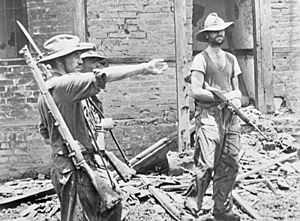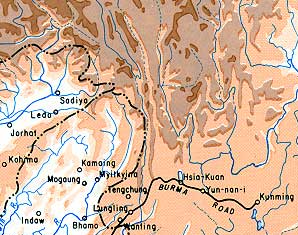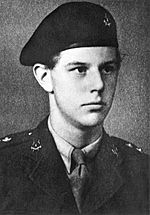Battle of Mogaung facts for kids
Quick facts for kids Battle of Mogaung |
|||||||
|---|---|---|---|---|---|---|---|
| Part of the Burma Campaign of the Second World War | |||||||
 Brigadier Mike Calvert (left) gives orders to Lieutenant-Colonel Shaw, with (right) Major James Lumley after the capture of Mogaung. |
|||||||
|
|||||||
| Belligerents | |||||||
|
|
|||||||
| Commanders and leaders | |||||||
| Units involved | |||||||
| Strength | |||||||
| 3,500 men | 4,000 men | ||||||
| Casualties and losses | |||||||
| 776 | 1,600 | ||||||
The Battle of Mogaung was an important fight during World War II in Burma. It happened between June 6 and June 26, 1944, in the town of Mogaung. In this tough battle, the British 77th 'Chindit' Brigade, led by Brigadier Michael Calvert, fought against the Japanese forces. Later, Chinese soldiers also joined the fight. Together, they managed to capture the town from Imperial Japan.
This battle was part of a bigger Chindit mission called Operation Thursday. It also connected with the Siege of Myitkyina, where Chinese and US forces were fighting. Capturing Mogaung was a big deal because it was the first place in Burma to be freed from Japanese control. It was also the last major battle for the Chindits in the war. Two very brave soldiers were given the Victoria Cross medal during this battle.
Contents
Why the Battle Happened
In 1943, a British group called the Chindits, led by Brigadier Orde Wingate, went deep behind Japanese lines. This was their first long-range mission, called Operation Loincloth. It didn't win the war, but it showed that British soldiers could fight just as well as the Japanese in the jungle.
The next year, in March 1944, the Japanese army invaded British India. General William 'Bill' Slim and his British Fourteenth Army were fighting hard against them. Because of this invasion, a second, much bigger Chindit mission was launched. It was called Operation Thursday and involved six brigades. Their goal was to bother the Japanese from behind their lines and cut off their supplies. This would help American General Vinegar 'Joe' Stilwell and his Chinese and US forces. They were moving south into Northern Burma to capture the important town of Myitkyina.
Early in the Chindit mission, Wingate died in a plane crash. Major General Walter Lentaigne then took command, but eventually, the Chindits were placed under General Stilwell. By this time, the 77th Brigade had been fighting since early March. They had held off stronger Japanese forces for two months from their base called White City.
Getting Ready for the Fight
In late May, General Stilwell ordered the Chindits to move north towards Mogaung. He wanted them to take pressure off his Chinese forces, who were having trouble at Myitkyina. If Mogaung was captured, it would cut off a key Japanese supply route to the north. This would make it easier for Myitkyina to fall.
By the end of May, British intelligence found out that the Japanese had sent more soldiers to Mogaung. About 4,000 Japanese troops from Lieutenant-General Hisashi Takeda's 53rd Division were defending the town. The 77th Brigade had about 3,500 men. They were made up of four battalions:
- 1st Battalion, the Lancashire Fusiliers
- 1st Battalion, the King's Regiment
- 1st Battalion, the South Staffordshire Regiment
- 3rd Battalion, the 6th Queen Elizabeth's Own Gurkha Rifles
The brigade also had RAF officers with them. They needed high ground to set up radios and call for air support.
Reaching Mogaung was going to be tough. There was no way to fly in. To the north was the fast-flowing Mogaung River, and to the west was the Wetthauk Chaung river. The land to the east and south had many lakes and swamps. The only way in was a two-mile road to Pinhmi, built on a raised path. The British would have to use this road. Villages on the edge of Mogaung were heavily fortified, with bunkers built under the houses.
The Battle Begins
On May 30, the 77th Brigade started their march. Their plan was to travel 160 miles to Mogaung using the Pinhmi road. Their first goal was to find a place for a small landing strip. This strip would be used to fly out sick and wounded soldiers and to drop supplies. Brigadier Calvert hoped to reach and even capture Mogaung by June 5.
Fighting at Lakum
The march was very hard. They moved through thick jungle with deep ravines. Sometimes, they had small fights with Japanese soldiers. But on June 2, the South Staffordshires and the Gurkhas captured the village of Lakum. This was after a fierce fight with the Japanese. Lakum was a low hill overlooking the plain, two miles southwest of Mogaung.
The next day, more tough fights pushed the Japanese off the hills around Lakum. The Gurkhas took a small village, which they called 'Gurkha Village'. They wiped out the forty Japanese soldiers defending it. They also captured a large ammunition dump, fifteen trucks, and a hidden hospital full of medical supplies. Many sick Japanese soldiers tried to escape but failed.
Calvert set up his headquarters just south of Lakum. A small airstrip was quickly built. Supplies were flown in by C-47 planes. Wounded and sick soldiers could be flown out using small Sentinel planes and even new Sikorsky R-4 helicopters. RAF officers set up a spot to call for air support from the US 1st Air Commando Group. This air support would help in the fight for Mogaung. Calvert also gathered a lot of medical, food, and military supplies before the main attack.
At the same time, local Kachin groups, led by former Burma Rifles officers, joined Calvert's men. They knew the area well and gave important information about Japanese movements. The next day, two groups of Lancashire Fusiliers captured a key spot on the Mogaung river called the Tapaw Ferry. This would be a useful escape route if the Chindits needed it.
The villages of Mahaung, Natgyigon, and the Pinhmi bridge were very important for Mogaung's defense. If these fell, the Japanese would not be able to hold the town. Inside Mogaung, the courthouse and railway station were strong buildings. They were expected to be areas of heavy resistance. Over the next few days, the brigade received supplies. They got PIAT anti-tank weapons, flamethrowers, and large mortars (3-inch and 4.2-inch) with thousands of rounds. These were their only heavy fire support. Japanese artillery was causing problems, but Calvert was able to call in P-51 Mustang planes to try and silence the Japanese guns.
Taking the Pinhmi Bridge and Outskirts
The attack on the Pinhmi to Mogaung road began on June 7. This road had the important Pinhmi bridge over the Wetthauk Chaung river. As they moved closer to Mogaung, the Staffordshires found and destroyed a Japanese ammunition dump. The Lancashire Fusiliers later captured the village of Pinhmi.
An attempt to take the bridge the next day failed. The Lancashires were pushed back by hidden Japanese positions along a fifteen-foot-high bank. They suffered many casualties. However, a scouting patrol found a shallow crossing further down the river. From there, the Gurkhas and Staffordshires attacked and took the village of Mahaung. They also secured the village of Ywathitgale, destroying a Japanese headquarters. They reached the Pinhmi–Mogaung road, getting around many Japanese positions. The Japanese launched counterattacks, but they were driven off.
On June 10, the Gurkhas tried to take the bridge again. The first try failed, but the second, using a wide flanking move, succeeded in taking the bridge. Captain Michael Allmand showed great bravery in helping capture the bridge. These attacks cost nearly 130 casualties. But Calvert's brigade was now firmly in control of the Pinhmi-Mogaung road.
The monsoon rains started later that day. Conditions became very tough for the 77th Brigade. Diseases like malaria, trench foot, and typhus spread quickly. Calvert learned that two more Japanese battalions had arrived to reinforce Mogaung. This meant the Japanese had replaced their losses. Seeing the difficulty, Calvert sent a message to Stilwell, but Stilwell was not very sympathetic. Stilwell eventually sent the 1/114th Chinese Infantry Regiment to help the Chindits.
On June 12, Calvert looked at his troops. Many battalions were so small they were like a single company. The brigade had no more than 750 fit men left. Calvert was worried about the wounded and sick soldiers in the bad conditions. It was impossible to dig trenches because of the wet ground. Soldiers had to lie face down in the mud if they were under shell fire. However, many wounded soldiers chose to stay and fight rather than be flown out.
Over the next few days, conditions slowly got better. Many wounded were flown out, and supplies were brought in again. On June 15, Calvert continued his attacks, fighting to secure a ridge closer to the town. The Court House was taken the next day. The area stretching to the Mogaung River and the edge of Natgyigon was cleared. Japanese mortar fire from the village of Naungkaiktaw was causing problems for the Chindits.
At dawn on June 18, air attacks and heavy mortar fire hit the Japanese. Then, the Lancashire Fusiliers and the King's attacked using flamethrowers. They succeeded, driving out about a hundred Japanese soldiers and killing seventy. This cost them about fifty casualties, some from friendly fire. While they were securing the village, a Japanese patrol was ambushed. They had not realized the village was now held by the British.
Around the same time, Chinese troops started to arrive. Gurkhas met them west of Lakum. Mogaung was then surrounded, with the Chinese to the south. They had nearly three battalions. Importantly, they had 75mm mountain guns. These were set up at Pinhmi and could pound Japanese positions.
The Final Push for Mogaung
Calvert planned his next attack for June 23 towards Natyigon. This was a key position and the last outer defense of Mogaung. At first light that day, the final attack began. Every fit man available was called up, including cooks, orderlies, and even headquarters staff. The Chinese attacked towards the railway station along the railway embankment. This was a strong line of defense. Despite heavy bombing, the attack failed. The Chinese were held back by intense Japanese machine gun fire. The Chindits had to stop along this line for the rest of the day.
Earlier scouting had found the 'Red House', a large brick building. The next day, after heavy bombing from Chinese guns and British mortars, and air attacks, the British attacked from the north of the station. Again, the fighting was intense. The Japanese defended bravely despite the constant pounding. The building and nearby positions were only taken after brutal fighting. Flamethrowers, grenades, and PIATs were used.
One of the brave soldiers involved was Rifleman Tulbahadur Pun. His single-handed bravery as part of the Gurkhas' attack on the 'Red House' earned him a nomination for the Victoria Cross. The other nomination went to Captain Michael Allmand. He attacked a machine-gun position that was stopping his company. He destroyed the position with grenades but was badly wounded and later died. The Chinese helped with fire support but did not join this attack. Instead, they protected the sides and cut off any Japanese escape routes. The Gurkhas' attack completely surprised the Japanese. Takeda had no choice but to pull back or risk losing all his soldiers.
The final attack was on the railway station on June 25. The Chinese attack from the south was delayed. But the Lancashires and the South Staffordshires went in anyway. After more heavy fighting, they finally took the damaged remains of the station and met up with the Chinese. With the British now holding a major part of the town, the Japanese launched several counterattacks that night. But they were beaten back. The next morning, Chindit and Chinese patrols found that Japanese positions outside the town were empty. Any Japanese who escaped did so by using oil drums to float downriver to Myitkyina. However, many were shot by patrolling Chindits.
With the battle mostly over, the Chindits secured their positions in Mogaung. But they were very tired, both physically and mentally. At the end of the battle, the brigade had fewer than 550 men left who could fight. The Lancashire Fusiliers, King's Regiment, and South Staffordshires together could only gather 300 men. The 3/6th Gurkhas had only 230 fit men left.
What Happened After the Battle
After Mogaung was captured, the Gurkhas stayed in the town. They prepared for more attacks from across the river, but none came. The Japanese had left the area completely. While in Mogaung, the Gurkhas held a small ceremony. They raised the Union Jack flag on a large pagoda, which was the tallest building still standing.
The Chindits stayed in the area until July 5. Then, they went back to their base at Pinhmi. They had to march another fifty miles to be flown back to India. They left Mogaung in the hands of the Chinese.
Mogaung was the first place in Burma to be freed from the Japanese. It was also the last major Chindit mission of the war. The Japanese had lost a lot, with nearly 1,600 casualties, most of whom died. An unknown number of sick Japanese soldiers were also moved out. Taking Mogaung had been very costly for the British. Calvert had lost 47 officers and 729 other soldiers killed or wounded. This was about fifty percent of his men.
General Stilwell had used the Chindits like regular infantry, even though they didn't have the support of artillery and tanks. He announced on the BBC that Chinese troops had captured Mogaung. But he didn't mention the British. The Chindits were very angry. Calvert famously sent a message to Stilwell's headquarters saying, 'Chinese reported taking Mogaung. My Brigade now taking umbrage.' Stilwell's son, who was an intelligence officer, joked that 'Umbrage was so small that I can't find it on the map'.
Calvert was worried that they would be ordered to join the siege of Myitkyina next. So, he turned off his radios and went to Kamaing, where Stilwell had his headquarters. A military trial seemed likely. But Stilwell and Calvert met in person. Stilwell finally understood how difficult the conditions were for the Chindits. The siege of Myitkyina had been a big problem for Stilwell. A major Chinese attack there had been pushed back with heavy losses. The British capture of Mogaung did help Stilwell's troops at Myitkyina. The Japanese left Myitkyina on August 3.
Two Victoria Crosses were given out after the battle. Michael Allmand received his after he died. Tul Bahadur Pun received his in November. Many other awards were given to the Gurkhas, South Staffordshires, Kings, and Lancashire Fusiliers. Calvert himself received the Distinguished Service Order and Bar, and the American Silver Star for capturing Mogaung. He was sent back to Britain for medical reasons after an injury in September 1944. In March 1945, he was put in charge of the Special Air Service Brigade. He led various missions during the Western Allied invasion of Germany, including Operation Amherst. He stayed in this role until the brigade was disbanded in October 1945.
Images for kids






